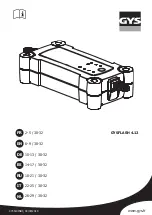
yellow
blue
4-43
The Certification/Tire label also tells you the maximum
weights for the front and rear axles, called Gross Axle Weight
Rating (GAWR). To find out the actual loads on your front
and rear axles, you need to go to a weigh station and weigh
your vehicle. Your dealer can help you with this. Be sure to
spread out your load equally on both sides of the centerline.
Never exceed the GVWR for your vehicle, or the
GAWR for either the front or rear axle.
If you do have a heavy load, you should spread it out.
Similar appearing vehicles may have different GVWRs
and payloads. Please note your vehicle’s
Certification/Tire label or consult your dealer for
additional details.
CAUTION:
Do not load your vehicle any heavier than the
GVWR, or either the maximum front or rear
GAWR. If you do, parts on your vehicle can
break, and it can change the way your vehicle
handles. These could cause you to lose control
and crash. Also, overloading can shorten the life
of your vehicle.
Using heavier suspension components to get added
durability might not change your weight ratings. Ask
your dealer to help you load your vehicle the right way.
NOTICE:
Your warranty does not cover parts or
components that fail because of overloading.
If you put things inside your vehicle
--
like suitcases,
tools, packages, or anything else
--
they will go as fast
as the vehicle goes. If you have to stop or turn quickly,
or if there is a crash, they’ll keep going.
Summary of Contents for 1999 Jimmy
Page 6: ...yellowblue vi NOTES ...
Page 64: ...yellowblue 1 58 NOTES ...
Page 138: ...yellowblue 2 74 Optional Cluster Canada Similar ...
Page 151: ...yellowblue 2 87 NOTES ...
Page 152: ...yellowblue 2 88 NOTES ...
Page 196: ...yellowblue 3 44 NOTES ...
Page 354: ...yellowblue 6 68 NOTES ...
Page 405: ...yellowblue 7 51 Maintenance Record DATE ODOMETER READING SERVICED BY MAINTENANCE PERFORMED ...
Page 406: ...yellowblue 7 52 Maintenance Record DATE ODOMETER READING SERVICED BY MAINTENANCE PERFORMED ...
Page 420: ...yellowblue 8 14 NOTES ...
















































